| |
The river Hvitá in the southwest, forms the outlet of Hvítar-
vatn, and receives immediately below the lake, the waters
of Jokulkvisl, which has a rapid current and an abundance
of water brought down from the Kerlingarfjoll watershed,
where it will be remembered we crossed on our way from
Grananes. Several other tributaries from the west join it
further down, so that Hvítá becomes at once a deep and
rapid river, which as a rule cannot be forded, also on
account of its bed, which like all glacial rivers, is soft and
changeable.
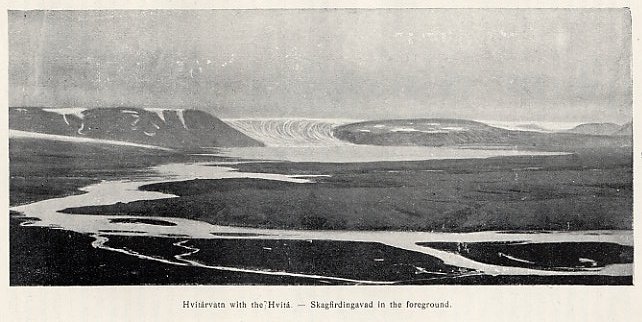
Hvítárvatn with the Hvítá - Skagfirdingavad in the foreground
In olden times, not far below the lake, there was a very
difficult ford "Skagfirdingavad". It had however been impas-
sable for some years, and in order that the shepherds could
cross from the parishes in the Geysir district to the country
east of Hvítárvatn, where they curiously enough have »Afrjett"
(grazing rights), boat-building materials were transported right
up Hvítá's head at the lake, and two boats were built, which
did good service for a long time. We however found them
in such a leaky condition that they were unusable, and had
therefore to essay the ford. We broke up our camp on the
east side of Hvítárvatn the 17th August, and rode away from
the beautiful green pastures over the flat swampy ground
towards the ford. After one and a half hours ride we reached
a Sosluhus, which lies on a low hill close by where the
boats crossed at the point where Hvítá bends to the east. As
we were unacquainted with the exact locality of the ford,
we had to search for it. Our attendants, especially Magnús,
were remarkably smart and daring; several times they tried
in vain, but it was too deep and the horses sank in. At last
however they succeeded in finding it.
About 500 yards southeast of the Sæluhús — down stream
— one rides down a declivity out to quite a small holm and
from this to a second and third — still keeping not far from
the left bank. From this last islet one swings across the
stream (rather a little against than with it), to the north end
of a small island, and from this against the stream to a
large island, and so to the other bank.
The ford is far from safe, for only a yard or two to the
side lies a soft bottom and quicksands. Magnús for instance
went head first over his horse through its forelegs sinking in
suddenly. How he saved himself I dont even now quite
understand, but in a trice both he and his horse were up again.
His arms had been so deep in the quicksand, that it had
gone up his sleeves from his wrists right up to the
shoulders. Shortly after I myself got too far to one side, in mid-
stream, and my horse began to swim down stream. Magnús
saw it happen, and driving his heels into his horse was
beside me in a moment, while the water splashed up on all
sides around us. Although there was no great danger, I shall
not easily forget the great promptness with which he came
to my assistance. It was characteristic of the man, he had
here, as always, his eyes about him. I had however got wet
and had to change my clothes, and as it was raining, we
pitched our tents immediately beyond the ford, and remained
here until next day. From the top of the aclivity on which
we were camped, we enjoyed a wonderfully beautiful prospect
over the jökull with its glaciers, the lake, the plain, and
Hvítá, which flowed in a whitish serpentine sweep along the
almost black, dusky, stony plain, ,"Hvítárnes" (Plate III).
The next day, the 18tt1, we rode on towards Geysir, after
first having marked out the ford. The boats however have
since been put in order.
From the fording place we rode along Hvítá to the south,
passing east of "Bláfell". It is also practicable to ride west
of this mountain, whereby the swampy ground between it
and Hvítá is avoided. Nearly the whole landscape between
Blafell and Geysir is an undulating desolate sandy and stony
plain, where the soil has been washed away by the rains.
Here and there stand small earth and sand knolls with a
little vegetation on their tops, the remains of former splen-
dour. The landscape was however beautiful in spite of its
disconsolateness. Hvítá growled and foamed in the cleft on
the left. On the far side we saw the territory I had traver-
sed in 1897. Here lay a number of farms in the middle ages,
but now all is deserted and desolate. On our right was Lang-
jokall with its detached foot hills: Jarlhettur.
After 8 hours ride through this most desolate waste, we
reached Gullfoss, the vapours from which had been visible
for some time.
This waterfall is one of the sights of the whole tour. Hvítá
flows here above the fall between comparatively broad banks,
and then is suddenly narrowed and falls into a deep narrow
chasm between the basalt stratum, whence the water is
sucked aloft like fine dust particles into the air.
From Gullfoss to Geysir is one and a half to two hours
ride. The country is a little swampy, and it is not always easy
to find the way, but we are now again in inhabited parts
with a little farm here and there, and one can, if desired, ob-
tain an extra guide in the form of a boy or girl from one of
these, who is mounted in a trice ready to lead the way. On
the whole it is often just in the peopled districts that it is
especially difficult to trace the way, because there are so
many small bridle paths, none of which are distinguished in
any way, so that one
often is misled,
We descried the
vapours from the Geysirs on the far side of the Tungufljót and
crossing this ford, which is not always to be depended upon,
were soon at the foot of Laugarfell with its twenty odd steaming springs
among which the grand magnificent Geysir. The slope at the foot of the
hill is strewn with reddish-yellow silica, sand and clay.

Gullfoss.
We camped at the
usual spot just south of Geysir, where there is a little grass.
The Geysir springs are located on ground previously
belonging to the farm "Laug", but now owned by an Englishman, who
however, has not been heard of since the purchase. This was
my third visit at Geysir, and I have been there once since in
1905. The first time was in 1896, fourteen days before the
earthquake, and I was there again the next year, so that I could
observe the changes that had taken place under the
earthquake.
The first shock occurred on 26th August 1896 at 9-50 p.
m. (Th. Thoroddsen "Vulkaner og Jordsksælv paa Island")
just as people were going to bed,—60 farms were destroyed
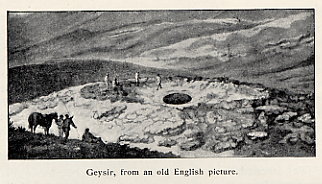
Geysir, from an old English picture.
in a moment here in the south. — On the morning of the
27th August severe shocks were again experienced, which
completed the destruction. In the days from the 27th Aug. to
the 4th September, the earthquake movement continued with
slight shocks and minor concussions all the time, so that
the people in the affected districts lay in tents at night. The
5th Sept. at 10-30 in the evening the south country was again
shaken by a violent shock, which lasted about a minute and
destroyed over 100 farms in Floi. The mountain sides were
enveloped by dustclouds from the countless hill slides, which plunged
down with such earsplitting roaring and booming that
people could not hear one another even when shouting.
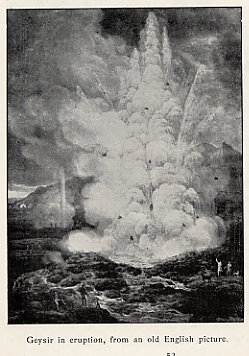
Geysir in eruption, from an old English picture.
The same night at 2 oclock came a still more frightful
earthquake, the most severe of them all. In scarcely half a mi-
nute 30 farms in Olfus lay in ruins. This night the shocks
were so violent that no one could stand upright, and the
people stretched themselves on the ground clinging fast to
rocks and tussocks. The shocks were accompanied by fear-
ful boomings and terrible crashes, while the earth rocked
like being tossed in a high sea, and to increase the horror
of it all, the bells rang as if for a funeral.
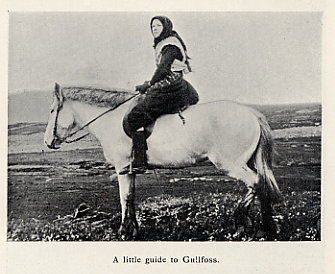
A little guide to Gullfoss.
During the first ten days of the earthquake period it seems,
according to what I gathered from some of the inhabitants
of the district, that no alteration was noticed in the Geysirs,
but under the great shock on the 4»h September, they all
spouted at once, and several new ones were formed at the
same time. The great Geysir received renewed vitality and
spouted several times daily. From 10 a. m. July 27th 1897 to
10-30 a. m. the 28th for instance, 1 observed at least fourteen
eruptions. On three of these occasions the jet emitted reached
a height of from 100 to 120 feet, but the other times a height
of 20 to 30 feet was seldom exceeded. The basin, which
usually is full with sea green crystal clear water which flows
away through small gutters in the brink, is only emptied
after the very highest spouts, when the throat is also
emptied as far down as one can see. After the eruptions the
basin is filled little by little with water again. The largest
spouts last about 10 minutes, and previous to their
commencement an underground booming is heard for some
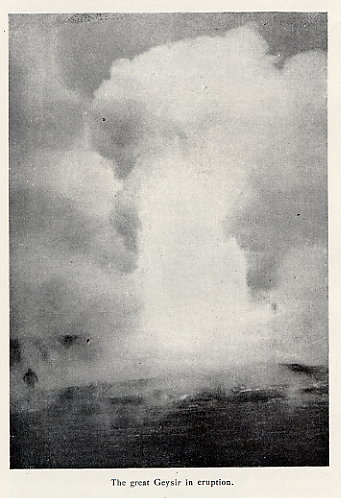
The great Geysir in eruption.
minutes. During the eruptions, skaking of the earth is noticed,
some times quite a good distance from the Geysir, even up
to 7 or 8 minutes walk from it in fact. In the big spouts the
column of boiling water rises half a dozen times. It begins
with large steam-bubbles which burst in the swelling
surface, then comes a moment's quietness, and then the eruption
continues with small springs gradually increasing, until
toward the close, when there come a couple of high jets. The
foaming column of water dissolved into finest raindrops is
more and more enveloped by clouds of vapour until the
eruption ceases with a couple of small jets. A stone thrown into
the Geysir when it is spouting is at once thrown into the
air again. The surface of the basin is usually enshrouded in
white vapour, which prevents the water-spouts being seen in
their full splendour. The intervals between the emissions
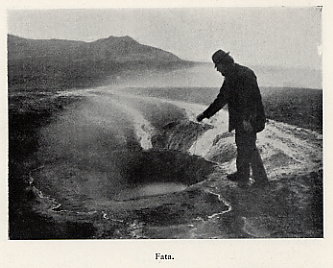
Fata.
vary greatly, the shortest I have observed being about half
an hour. The single springs follow often immediately upon
one another, in such a manner that before the first is finished
a second commences; but again just as often there is a
moment's quiet between two jets. — Geysir had, in the beginning
of the 19th century, an eruption once or more in twenty
four hours, but gradually their frequency decreased, until
shortly before the earthquake in 1896, at which time it only
spouted about once every five days.
On the accompanying sketch map (page 59) all the springs
are shown. The principle changes which took place during the
earthquake are as follows:
Geysir activity was at once increased but is now again on
the decline.
Konungshver (Nr.2) sprang up in an old extinct basin 15
feet in diameter. It spouts 2 to 3 feet, and water ouses out
of the side of the basin. Nr 3 is a small spring. The spec-
tacle-formed basin Blesi (the blazing, shining). Nr. 5, is 40
feet long by 16 feet wide; it had previously only one outlet,
but has now two, and the water bubbles up. The
composition of the water is also thought to have changed as the
petrification now has a blueish tint, whilst it was quite yellow
or reddish yellow before. Neither had it any noticeable taste,
whereas now it contains somewhat more sulphur, although
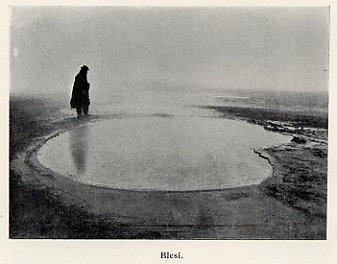
Blesi.
not more than that we could use it to our tea. In the east
outlet from Blesi lies a new spring called Stjarna (Nr. 4),
which has also risen since the earthquake. Is is said to have
spouted a few times, and a rumbling boom is heard from
two small holes 5 feet deep. Nr. 6 ,,Fata" (Bucket), is a little
spring 13 feet by 9 feet wide and 2 feet deep, where the
water sometimes sinks so far down that it cannot be seen.
Nr.7, Strokkur (Butter churn), arose under an earthquake
in 1784. Previously it boiled up to the brink, and could
generally be made to spout by plugging its mouth with turf,
but it is now quite inactive, and only contains dark tepid
dirty water, which froths up at long intervals, giving a
subsequent higher water level. The throat of the spring sinks
into the depths abruptly from the ground level. The socalled
"Little Geysir" or Otherrishola (Nr.8), springs to a height of
12 to 18 feet several times daily from two small oblong deep
holes, about one foot long by from 5 to 10 inches, surroun-
ded by red clay.
Little Strokkur is a well (2 feets wide) which boils vio-
lently. Near it lie a similar smaller well with yellow water,
and some blue-grey sloughs, one or two of which spout a
little.
Thykkuhverir is a group of large and small basins with
bubbling seething boiling water. Some of them were nearly
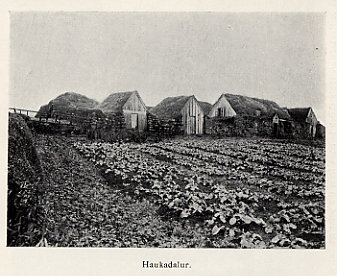
Haukadalur.
dry before the earthquake, but after this they burst up again.
The largest are Sisjodandi, (constantly boiling) Nr. 13, which
seethes up about one and a half feet; and Nr. 12, which still
spurts to a height of about two feet.
In several places, especially by the outlet from Little
Geysir, are sloughs and mud pools with red, blue, or reddish
yellow water or deposit. They bubble with a grunting or
sputtering noise.
Tourist accommodation has now been provided in a tourist
hut close by the Geysir springs with good beds and catering
during the summer.
In the neighbourhood of the Geysirs lies the farm Hauka-
dalur-with a. chwch. The farm is one of the farthest from the
coast in Iceland.
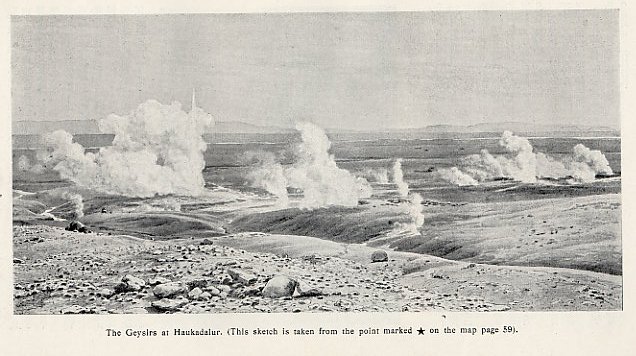
The Geysirs at Haukadalur. (This sketch is taken from the point marked * on
map page 59)
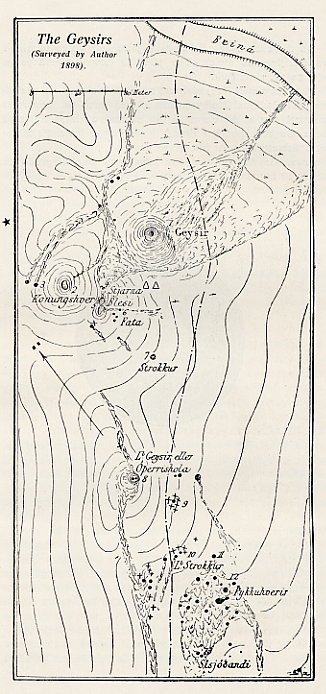
The Geysirs.
On the church door is a round plate with a ring to which
various legends attach. The plate is however perhaps an
old saddle ornament.
In olden times Haukadal was a chieftain's seat, and the re-
nowned Haukadal family, which played such an important
political part at the close of the commonwealth, originated
here. On this spot Are Frode, the father of Iceland's histo-
rical literature, spent his young days.
From Geysir we rode the usual way to Thingvellir in
about 10 hours and from there to Reykjavik.
|
|













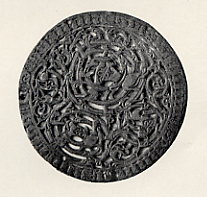
![]() Zurück zu Inhalt
Zurück zu Inhalt![]() nächstes Kapitel
nächstes Kapitel